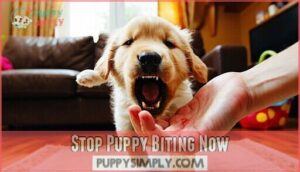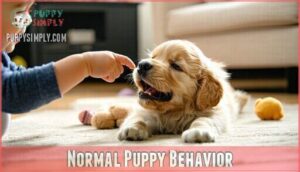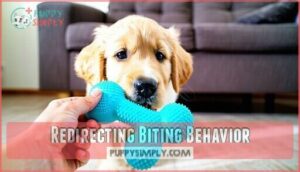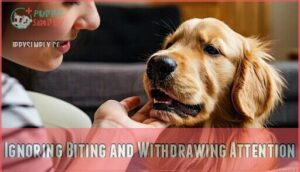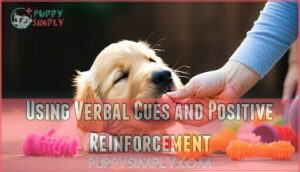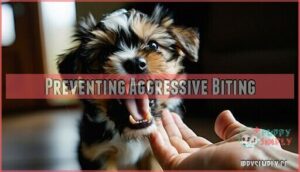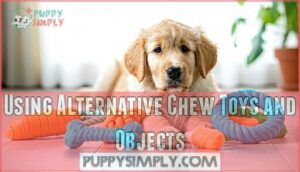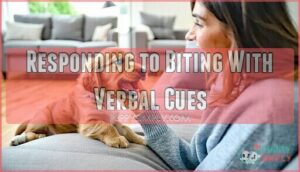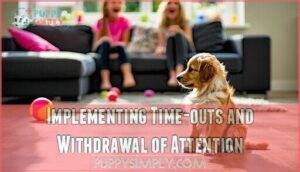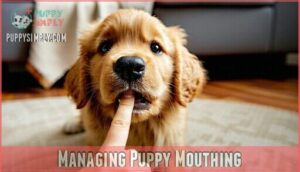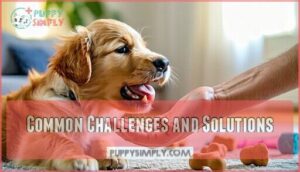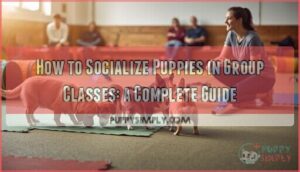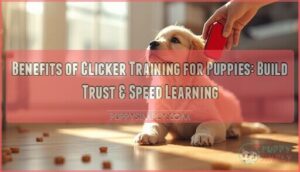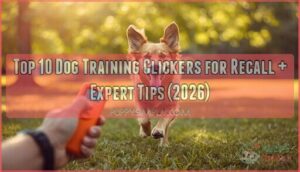This site is supported by our readers. We may earn a commission, at no cost to you, if you purchase through links.
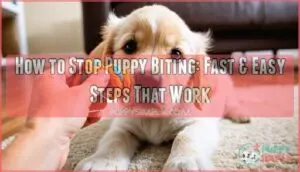
Say "no" firmly and withdraw your attention for 10-15 seconds. Don’t pull away quickly since this triggers their prey drive. Instead, stay still and ignore them completely.
Reward gentle behavior with treats and praise. Consistency is essential – everyone in your household must follow the same rules.
Puppies bite because they’re teething, exploring, or seeking attention. With patience and proper training, most puppies learn bite inhibition within a few weeks.
The key lies in understanding why your puppy bites and using specific techniques that work with their natural instincts.
Table Of Contents
- Key Takeaways
- Why Puppies Bite
- Stop Puppy Biting Now
- Normal Puppy Behavior
- Reasons for Puppy Biting
- Effective Training Techniques
- Preventing Aggressive Biting
- Teaching Bite Inhibition
- Managing Puppy Mouthing
- Common Challenges and Solutions
- Long-term Benefits of Training
- Frequently Asked Questions (FAQs)
- How do I Stop my puppy biting?
- How to train your puppy to stop biting?
- What should I do if my dog bites me?
- How do you punish a puppy if he bites you?
- At what age do puppies stop biting?
- How do I get my puppy to stop biting my hands and feet?
- How do I stop my puppy from biting my ankles when I walk?
- How do you discipline a puppy who is biting?
- At what age should puppies stop biting?
- What should I do to stop my puppy biting me?
- Conclusion
Key Takeaways
- Redirect immediately – When your puppy bites, say "no" firmly and instantly offer a chew toy instead of your hand or foot, then praise them for using the appropriate item.
- Withdraw attention completely – Stop all interaction for 10-15 seconds when they bite, staying still rather than pulling away quickly, which triggers their prey drive.
- Stay consistent across everyone – All family members must use the same commands and responses, or you’ll confuse your puppy and slow down training progress.
- Understand it’s temporary – Most puppies stop biting between 4-6 months as they finish teething, but consistent training during this period prevents future problems.
Why Puppies Bite
Your puppy’s biting isn’t random behavior—it’s their natural way of exploring the world and communicating their needs.
Understanding why puppies bite helps you address the root cause and train them more effectively.
Teething Discomfort
Around 12-16 weeks, your teething puppy’s gums become sore and swollen, triggering intense puppy biting behavior.
Those tiny teeth feel like needles when your puppy’s gums are screaming for relief.
Frozen toys and cold compresses provide natural relief during these teething stages.
Safe chews designed for puppy teething help massage tender gums while redirecting destructive chewing. Gum massage with your finger can also soothe discomfort effectively.
Boredom and Overstimulation
Your puppy’s energy-overload can trigger biting sprees when they’re understimulated or overwhelmed.
Bored puppies often turn to destructive behaviors like puppy biting, while overstimulated pups bite when excitement peaks beyond their control.
- Mental Stimulation through puzzle toys prevents puppy biting boredom
- Exercise Needs must be met daily to reduce excess energy buildup
- Quiet Spaces help overstimulated puppies decompress and reset
- Calming Techniques like gentle massage soothe frazzled nerves
- Routine Importance creates predictable schedules that prevent overstimulation
Prey Drive Instincts
Your puppy’s chasing instincts make moving hands and feet irresistible targets. Movement triggers their natural prey drive, causing them to lunge and bite at anything that moves quickly.
Breed tendencies influence this behavior – some dogs have stronger drives than others. Redirecting this drive toward appropriate toys helps manage puppy biting behavior.
Use calming techniques when overstimulation occurs, and provide structured play sessions to satisfy their hunting instincts safely.
Attention Seeking
Nothing grabs your puppy’s attention quite like the instant reaction they get from biting your hand.
This puppy biting behavior stems from learned patterns—when they nip, you respond with sounds, movement, or even scolding.
To break this cycle, ignore biting completely by turning away and withdrawing owner engagement.
Redirect attention to appropriate toys, then reward calmness with treats.
Consistent response from all family members prevents reinforcing puppy attentionseeking through biting.
Stop Puppy Biting Now
Your puppy’s razor-sharp teeth can turn playtime into a painful ordeal, but effective puppy biting training starts with swift action. The key to stop puppy biting lies in your immediate response and unwavering consistency.
Immediate Actions form the foundation of successful puppy biting solutions. When your puppy nips, respond instantly with a firm "no bite" and redirect their attention to an appropriate chew toy. This teaches them what’s acceptable to bite and what isn’t.
Consistent Response from every family member prevents confusion. If one person allows puppy nipping while another doesn’t, your training efforts will fail. Family Involvement guarantees everyone follows the same rules and uses identical verbal cues.
Here are three steps that work:
- React immediately – Don’t wait or ignore the bite
- Redirect their energy – Offer a toy or bone instead
- Reward good behavior – Praise gentle mouth contact.
Prevention Strategies include providing adequate mental stimulation and recognizing when your puppy needs rest. Overtired puppies bite more frequently, so guarantee they get 16-18 hours of sleep daily.
When puppy biting training doesn’t show progress after consistent effort, Professional Guidance becomes necessary to address underlying behavioral issues.
Normal Puppy Behavior
Understanding your puppy’s biting behavior is the first step to stopping it effectively.
Puppies bite and mouth as part of their natural development, exploring their world and learning social skills through play with littermates and their mother.
Play Biting and Mouthing
Play biting and mouthing are your puppy’s natural ways of exploring the world around them.
These behaviors help them learn about textures, sounds, and reactions through their mouths.
During social play with littermates, puppies practice gentle jaws and develop proper play inhibition.
Your puppy’s mouthing exploration isn’t aggression—it’s normal development that requires patient puppy biting training to redirect appropriately.
Bite Inhibition and Socialization
Learning bite force control happens through socialization with littermates and other puppies.
During puppy playdates, they discover that hard bites end playtime when others yelp and withdraw.
This natural feedback teaches appropriate pressure during human interaction.
Early experiences with diverse situations and gentle handling build confidence.
Proper socialization between 3-14 weeks prevents future puppy biting issues through structured bite inhibition training.
Socialization is key, as it helps with establishing communication boundaries and is crucial for puppy development.
Importance of Early Correction
Right now’s the time to act on puppy biting help.
What you do today shapes your dog’s future behavior. Consistent training during these early weeks prevents aggression and long-term issues that plague adult dogs.
Skip the correction now, and you’ll face serious adult risks later. Puppy biting prevention starts with immediate puppy biting redirection when teeth touch skin.
Reasons for Puppy Biting
Understanding why your puppy bites helps you address the behavior more effectively.
Most puppy biting stems from three main causes: seeking attention, natural playfulness combined with prey instincts, and teething discomfort that drives them to chew on everything within reach, which can be related to natural playfulness.
Attention Seeking Behavior
Your puppy bites because they’ve learned it gets your attention. Even negative responses like "no" or pulling away can reinforce puppy biting attention-seeking behavior.
Ignoring attention-seeking bites works better than scolding. When your puppy bites, withdraw attention immediately and redirect to appropriate toys.
Use positive reinforcement when they choose alternative behaviors. Consistent response from all family members prevents mixed signals about puppy biting behavior attention.
Playfulness and Prey Drive
When your puppy views your hands and feet as moving toys, their natural chasing instincts kick in.
This puppy playfulness mixed with prey drive creates playful nipping behaviors.
Breed tendencies influence how strong these instincts appear, but interactive games help channel this redirected energy appropriately.
- Moving hands trigger immediate pouncing and biting responses
- Dangling shoelaces become irresistible targets for quick snaps
- Running children activate the chase-and-grab hunting sequence
- Wiggling fingers mimic small prey animals your puppy wants to catch
Teething and Pain Relief
When your puppy’s adult teeth start pushing through around 12-16 weeks, their gums become sore and inflamed.
This discomfort drives puppy biting and chewing behavior as they seek relief.
Offer frozen treats, teething toys, and puppy-safe gels to soothe tender gums.
Cold compresses and gentle gum massage help reduce inflammation.
Proper teething relief prevents excessive puppy chewing on inappropriate items.
Effective Training Techniques
Training your puppy to stop biting requires consistent techniques that redirect their natural behavior toward appropriate outlets.
You’ll find success by combining redirection methods with positive reinforcement while maintaining patience throughout the process.
Redirecting Biting Behavior
When your puppy starts biting, immediately redirect their attention to appropriate toys or chew alternatives.
This redirection technique teaches impulse control while providing positive distraction and energy outlets for natural puppy biting behavior.
Here’s how to master puppy biting redirection:
- Keep chew toys accessible – Have multiple options within arm’s reach during play sessions
- Swap immediately – Replace your hand with a toy the moment teeth touch skin
- Use high-value alternatives – Frozen Kong toys or rope toys work better than basic chew items
- Praise the switch – Reward your puppy when they accept the redirection with enthusiasm
Selecting the right safe chew toys is essential for this process.
Ignoring Biting and Withdrawing Attention
Sometimes a cold shoulder works better than a warm hug. When your puppy bites, attention withdrawal becomes your strongest tool.
Ignoring effectiveness shows when you turn away without speaking or making eye contact. Consistency importance means everyone follows the same rule.
Your puppy biting attention-seeking behavior stops when they realize biting ends fun interactions. Puppy biting ignoring teaches consequences naturally through social isolation, and consistency is key to making this method work, as it helps to establish that ignoring is a direct result of unwanted behavior.
Using Verbal Cues and Positive Reinforcement
Commands like "ouch" or "no bite" work best when timed perfectly with the unwanted behavior.
Use verbal cue training paired with positive reinforcement timing to teach your puppy what’s acceptable. Rewarding calmness immediately after they stop biting strengthens the lesson.
Gentle mouth praise when they lick instead of bite builds trust. Consistency matters – everyone must use the same puppy biting tips for success.
To manage biting, provide your puppy with appropriate chew toys.
Consistency and Patience in Training
Building habits takes time, and puppy biting training techniques require unwavering consistency from everyone in your household.
When family involvement wavers, training setbacks multiply quickly.
Create a consistent environment where all members use identical commands and responses.
Maintain realistic expectations – gradual progress over weeks, not days, leads to lasting puppy training patience and success.
Preventing Aggressive Biting
While most puppy biting is normal behavior, you need to recognize when it crosses into aggression territory.
Signs like growling, stiff body posture, or bites that break skin require immediate professional intervention to prevent dangerous adult behaviors.
Identifying Aggression and Red Flags
While training techniques work for most puppies, recognizing when normal biting crosses into aggression requires careful observation.
Watch for these warning signs that indicate professional intervention may be needed:
- Resource Guarding – growling over food, toys, or spaces
- Severe Bites – punctures, deep scratches, or breaking skin
- Aggressive Postures – stiff body, raised hackles, intense staring
- Fear Biting – biting when cornered or handled
These puppy biting aggression signs distinguish normal puppy biting behavior from concerning puppy aggression requiring immediate attention.
Seeking Professional Help and Training
When persistent puppy biting professional help becomes necessary, seek certified trainers with proper trainer qualifications or behavior specialists experienced in advanced aggression cases.
Professional puppy training classes provide structured environments for learning bite inhibition. A puppy biting veterinarian advice consultation can rule out medical issues and discuss medication options if needed.
These professionals offer long-term support and customized puppy biting behavior professional strategies.
Avoiding Harsh Punishment and Fear
Harsh punishment backfires when addressing puppy biting behavior. Yelling, hitting, or intimidation creates Fear-based Biting and damages trust.
Positive Reinforcement builds stronger bonds while teaching appropriate behavior through Gentle Methods focused on Anxiety Reduction. A puppy’s biting can sometimes be attributed to resource guarding tendencies.
Here’s how to maintain effective puppy biting prevention:
- Replace punishment with redirection – Guide your puppy to appropriate chew toys instead of scolding
- Use calm, consistent responses – Avoid emotional reactions that escalate puppy biting behavior modification needs
- Reward good behavior immediately – Offer treats and praise when your puppy chooses gentle play over biting
Building Trust requires patience and understanding. Your puppy learns faster through positive puppy biting training than fear-based corrections that often worsen the problem.
Encouraging Gentle Mouth Behavior
When your puppy mouths you, respond with rewards for gentle interaction.
This puppy biting help technique teaches bite inhibition naturally.
Use alternative commands like "gentle" when they soften their mouth.
Monitor progress through consistent training sessions.
Reward calmness immediately after gentle contact.
This puppy biting prevention method works better than punishment for stopping unwanted behaviors.
| Behavior | Your Response | Puppy’s Learning |
|---|---|---|
| Soft mouthing | Praise and treats | Gentle touch gets rewards |
| Hard biting | Remove attention | Rough play stops fun |
| Calm approach | Pet and play | Good behavior continues |
Teaching Bite Inhibition
Teaching bite inhibition is one of the most important skills you can teach your puppy.
This training helps your puppy learn to control the pressure of their bite, which prevents injuries and creates a safer relationship for everyone.
Using Alternative Chew Toys and Objects
Redirecting your puppy’s bite toward appropriate objects saves your hands and furniture. Choose safe chew toys designed for teething puppies to satisfy their natural urge to gnaw. Many owners find success with durable puppy products designed for this stage.
- Safe Chew Toys: Select rubber or rope toys specifically made for puppies
- Interactive Puzzles: Use puzzle toys that dispense treats during chewing
- Frozen Treats: Freeze wet washcloths or puppy-safe ice cubes for sore gums
- DIY Options: Create safe alternatives using old socks with treats inside
- Rotation Strategy: Switch toys weekly to maintain interest and prevent boredom
Responding to Biting With Verbal Cues
Communication plays a pivotal role in teaching your puppy proper bite inhibition. When your puppy bites, use a high-pitched "ouch" or firm "no bite" command immediately.
The ouch effectiveness depends on consistency – use the same verbal cue every time. High-pitched yelping mimics how littermates communicate pain.
Follow your verbal cue with redirection to an appropriate toy. Remember, herding instincts can trigger nipping behavior.
Remember, verbal cue consistency across all family members accelerates training success and reduces confusion.
Rewarding Gentle Mouth Behavior and Calmness
Positive reinforcement works like magic when your puppy shows gentle mouth behavior.
The moment they soften their bite or pull away, offer immediate praise and treats.
This reward timing teaches calmness association with gentle touch.
Consistent praise reinforces calm handling over rough play.
Your puppy learns that soft mouths earn rewards, creating lasting behavior change.
Selecting the right puppy training treats can substantially enhance this process.
Implementing Time-outs and Withdrawal of Attention
When your puppy bites, immediately stop all interaction and turn away.
This consistent withdrawal teaches that biting ends fun time.
Use short timeouts lasting 10-20 seconds – long enough to make the point without causing stress.
If attention seeking continues, calmly leave the room.
This method establishes clear puppy boundaries through consistent consequences.
Managing Puppy Mouthing
You’ll need to understand the difference between normal puppy mouthing and problem biting to address each behavior correctly.
Teaching your puppy alternative commands and monitoring their progress helps create lasting changes in how they interact with you and others, which can lead to a better understanding of alternative commands.
Distinguishing Between Mouthing and Biting
Understanding the difference between puppy mouthing and puppy biting starts with observing bite pressure and intent.
When your puppy mouthing involves gentle skin contact without pressure, it’s exploratory behavior.
Puppy biting play typically includes harder pressure and more intensity.
Context clues help too – relaxed body language suggests mouthing, while stiff posture indicates problematic puppy biting behavior.
Puppy age affects these behaviors substantially.
Teaching Alternative Behaviors and Commands
You’ll transform mouthy behavior into good manners through consistent command training and positive reinforcement.
Teaching specific commands gives your puppy clear alternatives to biting.
- "Drop it" command – Practice with chew toy substitution when puppy mouths inappropriate items
- "Sit" for impulse control – Require sitting before meals, play, or attention to build self-control
- "Gentle" cue – Say this during interactions, rewarding soft mouth contact with treats
- Calmness training – Use "settle" command paired with puppy biting redirection to appropriate behaviors
To guarantee success, remember to use consistent hand signals during training.
Encouraging Gentle Play and Interaction
Transform play sessions into gentle interactions by establishing clear boundaries.
Use interactive games with appropriate toys rather than hands during supervised playtime.
Safe playdates with well-behaved puppies teach proper social skills.
When your puppy engages in play biting, redirect to preferred toys immediately.
Positive reinforcement works best—reward calm behavior and gentle mouthing.
This puppy biting behavior redirection creates lasting habits for appropriate play and teaches proper social skills.
Monitoring Progress and Adjusting Training
Track bite frequency weekly to spot patterns and improvements.
Adjust training methods if progress stalls after two weeks.
Evaluate bite inhibition by testing gentle mouth contact during play.
Monitor socialization success with other puppies and people.
Review progress regularly with family members to guarantee consistency.
If puppy biting behavior management isn’t working, consider professional puppy biting behavior training solutions.
Common Challenges and Solutions
Even well-trained puppies can face specific challenges that make biting behavior more difficult to control.
Understanding these common obstacles helps you adjust your approach and maintain progress in your training efforts, which is crucial for complete training.
Overcoming Overtiredness and Biting
Overtired puppies often show increased puppy biting behavior, making Rest Schedules essential for managing puppy biting tiredness.
Create Quiet Spaces where your puppy can retreat when overwhelmed. Watch for Sleep Cues like excessive nipping or hyperactivity—these signal nap time.
Implement Calming Techniques and structured Puppy Naps throughout the day. Young puppies need 16-18 hours of sleep daily to prevent puppy biting overstimulation episodes.
Managing Overstimulation and Excitement
Puppies get overwhelmed when there’s too much happening around them.
Signs include excessive puppy biting, overstimulation, jumping, and frantic behavior.
Create quiet spaces where your puppy can retreat.
Use calming techniques like gentle massage or soft music.
Balance exercise with rest periods throughout the day.
Set consistent boundaries during playtime to prevent puppy biting behavior overstimulation from escalating into aggressive puppy biting management issues.
Early socialization is key, so consider introducing new people safely to help with puppy biting and overall development, ensuring a well-rounded and calm puppy through gentle massage.
Addressing Fear and Frustration-Based Biting
Fear-based biting happens when your puppy feels cornered or threatened, triggering defensive snapping.
Watch for ears back, tail tucked, and tense posture—these signal puppy biting anxiety.
Address these puppy biting behavior issues through:
- Creating safe spaces where your puppy can retreat
- Building confidence with gradual exposure and positive reinforcement
- Anxiety reduction by avoiding punitive measures that worsen fear
Consider consulting a puppy biting behaviorist for persistent issues.
Maintaining Consistency and Patience in Training
Success depends on every family member using the same puppy training consistency approach.
When one person allows biting while another corrects it, you’re sending mixed signals that confuse your puppy.
Set realistic expectations – puppy biting behavior reinforcement takes weeks, not days.
Use consistent commands like "no bite" followed by puppy biting timeout.
Avoiding frustration requires patience and long-term commitment to truly puppy biting stop.
Long-term Benefits of Training
Training your puppy to stop biting now sets the foundation for a lifetime of safe, enjoyable interactions.
You’ll create a well-behaved adult dog who knows how to play gently and respect boundaries with people and other animals.
Preventing Adult Aggression and Biting
Training your puppy properly creates a foundation that prevents dangerous adult behaviors.
Early socialization and consistent training methods teach your dog appropriate boundaries before bad habits solidify into serious problems.
- Professional intervention helps identify puppy aggression early and provides targeted solutions
- Responsible ownership includes understanding breed considerations that influence biting tendencies
- Consistent training prevents puppy biting behavior from escalating into adult aggression issues
Encouraging Socialization and Good Behavior
Your puppy’s early training creates lasting socialization benefits that extend far beyond stopping bites.
Proper socialization builds confidence and positive associations with people, animals, and new experiences.
Supervised playdates teach appropriate interaction skills while gentle handling prevents fear-based reactions.
| Socialization Activity | Behavior Benefit |
|---|---|
| Puppy classes | Learns bite inhibition with peers |
| Supervised playdates | Develops social skills safely |
| Gentle handling exercises | Reduces fear of touch |
| New environment exposure | Builds confidence |
| Meeting different people | Creates positive associations |
Well-socialized puppies show less anxiety and aggression throughout their lives.
They’re more adaptable to new situations and handle stress better.
This foundation makes them welcome companions in public spaces and family gatherings.
Strengthening Bond and Trust With Puppy
When you correct puppy biting through positive reinforcement and gentle handling, you’re building something bigger than obedience.
Each moment of consistent affection and playful interaction creates trust.
Your puppy learns you’re safe, predictable, and worth listening to.
This foundation of building confidence through patient puppy training strengthens your relationship.
Proper bite inhibition work shows your puppy you care about their development, creating lasting bonds.
Ensuring Public Safety and Responsible Pet Ownership
Every responsible dog owner plays a vital role in community safety through proper puppy biting behavior prevention and puppy biting safety measures.
Your commitment to puppy biting behavior solutions protects neighbors and guarantees compliance with local regulations.
- Follow leash law enforcement and insurance liability requirements in your area
- Apply bite prevention tips and dog owner education principles consistently
- Understand breed-specific legislation and puppy biting general precautions for your community
Frequently Asked Questions (FAQs)
How do I Stop my puppy biting?
Like taming a wild river, redirect your pup’s biting energy into appropriate channels. Use firm "no" commands, immediately offer chew toys, and consistently ignore attention-seeking nips to teach proper boundaries.
How to train your puppy to stop biting?
Redirect biting to appropriate chew toys immediately.
Use a firm "no bite" command, then offer the toy.
Reward gentle play with treats and praise.
Stay consistent—everyone must respond the same way for effective training.
What should I do if my dog bites me?
When your dog’s teeth find their mark, it’s like a sharp wake-up call.
Stay calm and don’t yell or pull away. Say "ouch" firmly, then redirect to a toy.
If it’s aggressive biting with growling or stiff posture, seek professional help immediately.
How do you punish a puppy if he bites you?
Don’t punish your puppy for biting. Instead, make a high-pitched "ouch!" sound and immediately stop playing. Walk away or redirect them to a chew toy. Consistency teaches bite inhibition effectively.
At what age do puppies stop biting?
Most puppies stop biting between 4-6 months when their adult teeth come in. However, some continue until 7 months. Consistent training accelerates this process substantially.
How do I get my puppy to stop biting my hands and feet?
When your puppy grabs your hands or feet, immediately stop moving and make a high-pitched "ouch!" sound.
Then redirect them to an appropriate chew toy and praise when they use it instead.
How do I stop my puppy from biting my ankles when I walk?
Unlike gentle play biting, ankle attacks happen when you’re moving – your puppy’s chasing instincts kick in.
Stop walking immediately, stand still like a statue, and redirect them to a toy.
Consistency breaks this habit quickly.
How do you discipline a puppy who is biting?
Use redirection when your pup bites—say "ouch" firmly, then immediately offer a chew toy. Walk away if they persist. Consistency from everyone helps teach bite inhibition effectively.
At what age should puppies stop biting?
Your pup’s biting should substantially decrease by 4-5 months and stop completely by 7 months. If they’re still chomping after 6 months, you’ll need professional help to address this behavior.
What should I do to stop my puppy biting me?
Like teaching a dancer to mind their feet, redirect your puppy’s teeth to appropriate chew toys.
Immediately say "ouch" when they bite, withdraw attention, and reward gentle behavior with treats and praise consistently.
Conclusion
Remember Rome wasn’t built in a day, and neither is perfect puppy behavior.
Learning how to stop puppy biting takes patience, but the results are worth it.
You’ve got the tools to redirect their energy, teach bite inhibition, and build a stronger bond.
Stay consistent with your training methods, and don’t give up when progress seems slow.
Your puppy will develop gentle mouth habits that last a lifetime.
Keep practicing these techniques daily for the best results.
- https://www.petmd.com/dog/training/puppy-biting
- https://www.aspca.org/pet-care/dog-care/common-dog-behavior-issues/mouthing-nipping-and-biting-puppies
- https://www.instinctdogtraining.com/6-reasons-your-puppy-is-biting-you/
- https://www.akc.org/expert-advice/training/puppy-mouthing-expert-tips/
- https://www.purina.com/articles/dog/puppy/behavior/how-to-stop-puppy-biting

